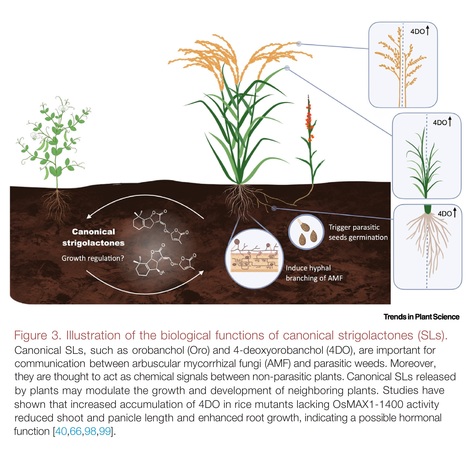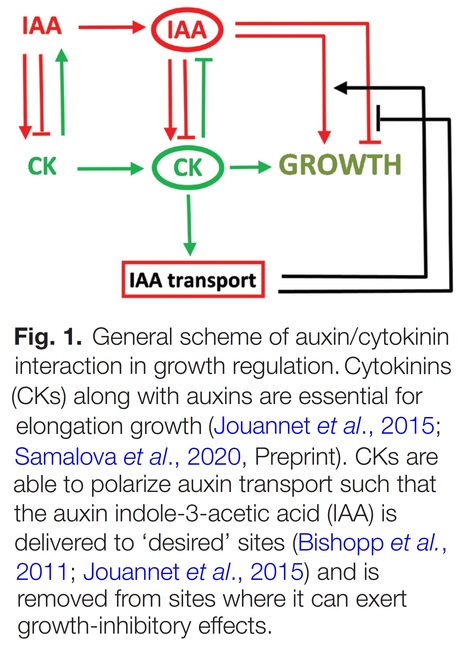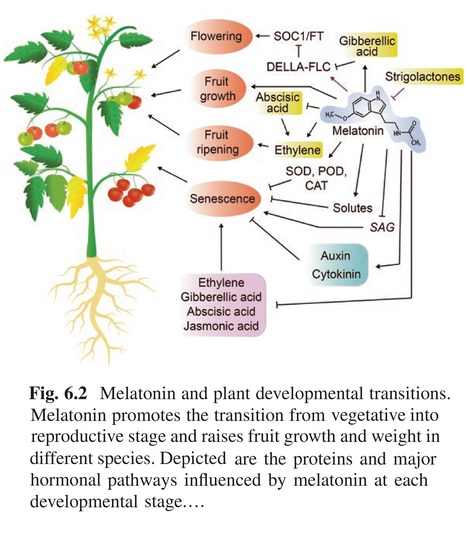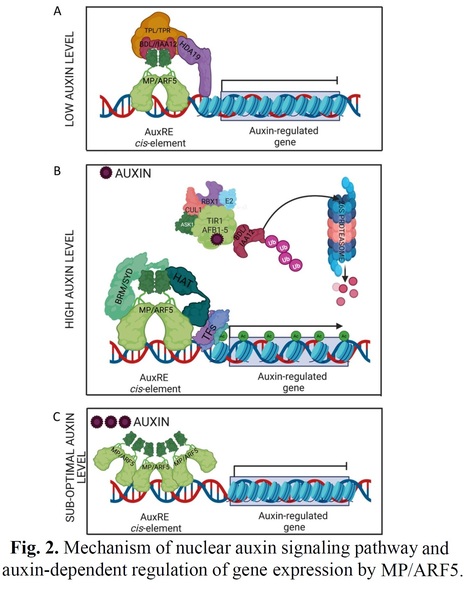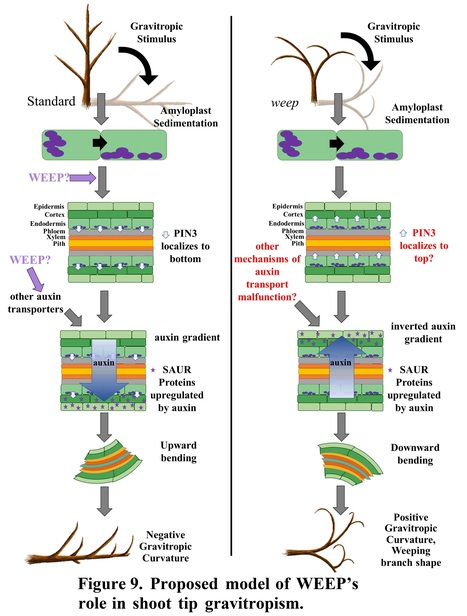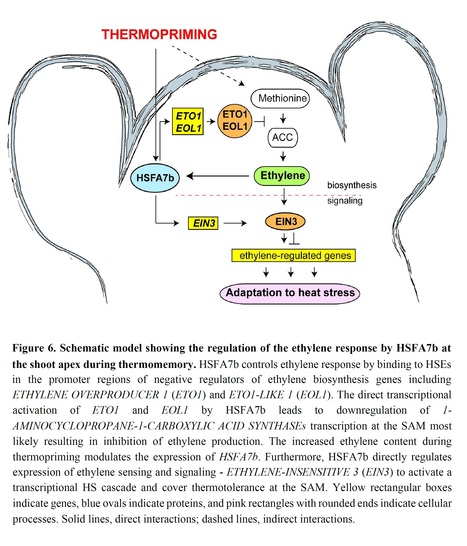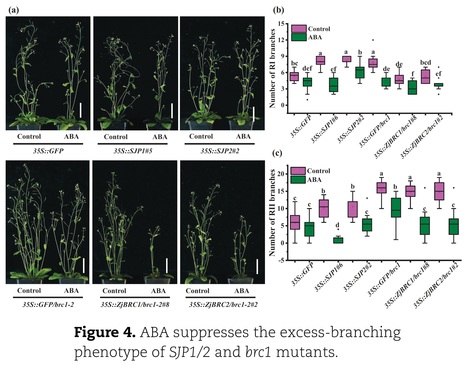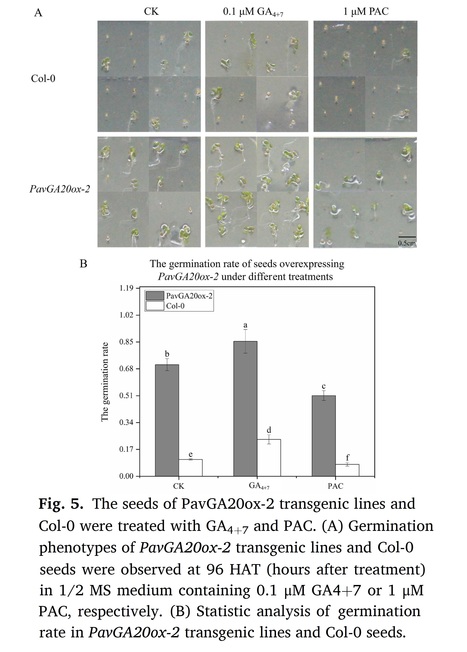 Your new post is loading...
 Your new post is loading...
Authors: Jian You Wang, Guan-Ting Erica Chen, Justine Braguy and Salim Al-Babili.
Trends in Plant Science (2024)
Highlights: Strigolactones (SLs) are structurally diverse and divided into canonical and non-canonical subgroups. SLs are generally considered as plant hormones, best known for inhibiting shoot branching/tillering. SLs are rhizospheric signals important for arbuscular mycorrhizal symbiosis, which may be their ancestral function that is conserved from liverworts to flowering plants. Recent results have revealed functional specificity, indicating that canonical SLs are not the tillering/branching inhibitory hormone in rice or tomato. Increasing the content of 4-deoxyorobanchol in rice by interrupting its hydroxylation affects root, shoot, and panicle growth, suggesting that this canonical SL has hormonal functions. Reducing the levels of canonical SLs by genome editing or applying specific inhibitors is a promising strategy for reducing Striga parasitism.
Abstract: "Strigolactones (SLs) act as regulators of plant architecture as well as signals in rhizospheric communications. Reduced availability of minerals, particularly phosphorus, leads to an increase in the formation and release of SLs that enable adaptation of root and shoot architecture to nutrient limitation and, simultaneously, attract arbuscular mycorrhizal fungi (AMF) for establishing beneficial symbiosis. Based on their chemical structure, SLs are designated as either canonical or non-canonical; however, the question of whether the two classes are also distinguished in their biological functions remained largely elusive until recently. In this review we summarize the latest advances in SL biosynthesis and highlight new findings pointing to rhizospheric signaling as the major function of canonical SLs."
Authors: Omid Karami, Azadeh Khadem, Arezoo Rahimi, Nicola Zagari, Simon Aigner and Remko Offringa.
The Plant Journal (2024)
Significance Statement: It has been a longstanding question why the synthetic auxin 2,4-dichlorophenoxyacetic acid (2,4-D) is so effective in inducing plant regeneration. Here we show that the secret lies in its inefficient export from plant cells and that using natural auxins can be as effective, even leading to improved regeneration, when their efflux is transiently inhibited.
Abstract: "Plant genome editing and propagation are important tools in crop breeding and production. Both rely heavily on the development of efficient in vitro plant regeneration systems. Two prominent regeneration systems that are widely employed in crop production are somatic embryogenesis (SE) and de novo shoot regeneration. In many of the protocols for SE or shoot regeneration, explants are treated with the synthetic auxin analog 2,4-dichlorophenoxyacetic acid (2,4-D), since natural auxins, such as indole-3-acetic acid (IAA) or 4-chloroindole-3-acetic acid (4-Cl-IAA), are less effective or even fail to induce regeneration. Based on previous reports that 2,4-D, compared to endogenous auxins, is not effectively exported from plant cells, we investigated whether efflux inhibition of endogenous auxins could convert these auxins into efficient inducers of SE in Arabidopsis immature zygotic embryos (IZEs). We show that natural auxins and synthetic analogs thereof become efficient inducers of SE when their efflux is transiently inhibited by co-application of the auxin transport inhibitor naphthylphthalamic acid (NPA). Moreover, IZEs of auxin efflux mutants pin2 or abcb1 abcb19 show enhanced SE efficiency when treated with IAA or efflux-inhibited IAA, confirming that auxin efflux reduces the efficiency of Arabidopsis SE. Importantly, in contrast to the 2,4-D system, where only 50–60% of the embryos converted to seedlings, all SEs induced by transport-inhibited natural auxins converted to seedlings. Efflux-inhibited IAA, like 2,4-D, also efficiently induced SE from carrot suspension cells, whereas IAA alone could not, and efflux-inhibited 4-Cl-IAA significantly improved de novo shoot regeneration in Brassica napus. Our data provides new insights into the action of 2,4-D as an efficient inducer of plant regeneration but also shows that replacing this synthetic auxin for efflux-inhibited natural auxin significantly improves different types of plant regeneration, leading to a more synchronized and homogenous development of the regenerated plants."
Authors: Nana Fan, Liantai Su, Aimin Lv, Wuwu Wen, Li Gao, Xiangkai You, Peng Zhou and Yuan An.
Plant Physiology (2024)
One-sentence summary: A pectin acetylesterase participates in indole acetic acid signaling pathways and affects shoot branching in alfalfa.
Abstract: "Shoot branching is an important biological trait affecting alfalfa (Medicago sativa L.) production, but its development is complicated and the mechanism is not fully clear. In the present study, pectin acetylesterase 12 (MsPAE12) and NAM/ATAF/CUC-domain transcription factor gene (MsNAC73) were isolated from alfalfa. MsPAE12 was highly expressed in shoot apexes, and MsNAC73 was found to be a key transcriptional repressor of MsPAE12 by directly binding to SA and JA elements in the MsPAE12 promoter. The biological functions of MsPAE12 and MsNAC73 were studied through overexpression (OE) and down-expression (RNAi) of the two genes in alfalfa. The numbers of shoot branches increased in MsPAE12-OE lines but decreased in MsPAE12-RNAi and MsNAC73-OE plants, which was negatively related to their indole-3-acetic acid (IAA) accumulation in shoot apexes. Furthermore, the contents of acetic acid (AA) in shoot apexes decreased in MsPAE12-OE plants but increased in MsPAE12-RNAi and MsNAC73-OE plants. The changes of AA contents were positively related to the expression of TRYPTOPHAN AMINOTRANSFERASE 1 (MsTAA1), TRYPTOPHAN AMINOTRANSFERASE-RELATED 2 (MsTAR2) and YUCCA flavin monooxygenase (MsYUCC4) and the contents of tryptophan (Trp), indole-3-pyruvic acid (IPA) and IAA in shoot apexes of MsPAE12-OE, MsPAE12-RNAi and MsNAC73-OE plants. Exogenous application of AA to WT and MsPAE12-OE plants increased Trp, IPA and IAA contents and decreased branch number. Exogenous IAA suppressed shoot branching in MsPAE12-OE plants, but exogenous IAA inhibitors increased shoot branching in MsPAE12-RNAi plants. These results indicate that the MsNAC73-MsPAE12 module regulates auxin-modulated shoot branching via affecting acetic acid accumulation in shoot apexes of alfalfa."
Authors: Shalini Yadav, Harish Kumar, Monika Mahajan, Sangram Keshari Sahu, Sharad Kumar Singh and Ram Kishor Yadav.
Development (2024)
Summary: Locally produced auxin and transport control the patterning of the shoot apical meristem into the central zone, peripheral zone and rib meristem in Arabidopsis.
Abstract: "The shoot apical meristem (SAM) of higher plants comprises distinct functional zones. The central zone (CZ) is located at the meristem summit and harbors pluripotent stem cells. Stem cells undergo cell division within the CZ and give rise to descendants, which enter the peripheral zone (PZ) and become recruited into lateral organs. Stem cell daughters that are pushed underneath the CZ form rib meristem (RM). To unravel the mechanism of meristem development, it is essential to know how stem cells adopt distinct cell fates in the SAM. Here, we show that meristem patterning and floral organ primordia formation, besides auxin transport, are regulated by auxin biosynthesis mediated by two closely related genes of the TRYPTOPHAN AMINOTRANSFERASE family. In Arabidopsis SAM, TAA1 and TAR2 played a role in maintaining auxin responses and the identity of PZ cell types. In the absence of auxin biosynthesis and transport, the expression pattern of the marker genes linked to the patterning of the SAM is perturbed. Our results prove that local auxin biosynthesis, in concert with transport, controls the patterning of the SAM into the CZ, PZ and RM."
Authors: Andrey A. Kotov and Liudmila M. Kotova.
Journal of Experimental Botany (2023)
Abstract: "Cammarata et al. (2023) show that in the model non-vascular plant Physcomitrium patens the growth hormone indole acetic acid (IAA) can inhibit growth and development of leaves (phyllids) from shoots, while cytokinin (CK) eliminates this effect. Most significantly, the effect on growth of the observed antagonism between IAA and CK has also been reported for vascular plants in the literature. These new data from moss emphasize the evolutionary preservation of this interaction between these hormones in the control of shoot growth."
Authors: Go Takahashi, Tomohiro Kiyosue and Yuki Hirakawa.
Current Biology (2023)
Editor's view: Takahashi et al. report a NAC domain transcription factor, JINGASA/MpJIN, in the liverwort Marchantia polymorpha as a target of MpCLE2 peptide signaling. MpJIN promotes periclinal cell division in the stem cell zone and affects stem cell maintenance, which likely represents a mechanism shared among the meristems of land plants.
Highlights • MpCLE2 peptide signaling suppresses the expression of MpJIN transcription factor • MpJIN expression level is varied among cells in the stem cell zone • MpJIN promotes periclinal division and affects stem cell maintenance • Expression data suggest the conservation of JIN/FEZ family in land plant meristems
Abstract: "Land plants undergo indeterminate growth by the activity of meristems in both gametophyte (haploid) and sporophyte (diploid) generations. In the sporophyte of the flowering plant Arabidopsis thaliana, the apical meristems are located at the shoot and root tips in which a number of regulatory gene homologs are shared for their development, implying deep evolutionary origins. However, little is known about their functional conservation with gametophytic meristems in distantly related land plants such as bryophytes, even though genomic studies have revealed that the subfamily-level diversity of regulatory genes is mostly conserved throughout land plants. Here, we show that a NAM/ATAF/CUC (NAC) domain transcription factor, JINGASA (MpJIN), acts downstream of CLAVATA3 (CLV3)/ESR-related (CLE) peptide signaling and controls stem cell behavior in the gametophytic shoot apical meristem of the liverwort Marchantia polymorpha. In the meristem, strong MpJIN expression was associated with the periclinal cell division at the periphery of the stem cell zone (SCZ), whereas faint MpJIN expression was found at the center of the SCZ. Time course observation indicates that the MpJIN-negative cells are lost from the SCZ and respecified de novo at two separate positions during the dichotomous branching event. Consistently, the induction of MpJIN results in ectopic periclinal cell division in the SCZ and meristem termination. Based on the comparative expression data, we speculate that the function of JIN/FEZ subfamily genes was shared among the shoot apical meristems in the gametophyte and sporophyte generations in early land plants but was lost in certain lineages, including the flowering plant A. thaliana."
Authors: Guan-Ting Erica Chen, Jian You Wang, Cristina Votta, Justine Braguy, Muhammad Jamil, Gwendolyn K. Kirschner, Valentina Fiorilli, Lamis Berqdar, Aparna Balakrishna, Ikram Blilou, Luisa Lanfranco and Salim Al-Babili.
PNAS (2023)
Significance: Strigolactones (SLs) are multifunctional, structurally diverse secondary metabolites fulfilling the function of a hormone. Whether a particular SL exerts specific functions is one of the most important questions in SL biology. Here, we generated and characterized rice mutants lacking the common SLs 4-deoxyorobanchol and/or its derivative orobanchol, which represent one of the two SL subfamilies, i.e., canonical SLs. We show that 4-deoxyorobanchol is not a determinant of shoot branching, but has a specific function as a regulator of shoot, root, and panicle growth. Accumulation of 4-deoxyorobanchol affects auxin homeostasis and negatively impacts the symbiosis with mycorrhizal fungi. Our data reveal specific hormonal functions of canonical SLs and pave the way for targeted modulation of rice architecture and rhizospheric interactions.
Abstract: "Strigolactones (SLs) regulate many developmental processes, including shoot-branching/tillering, and mediate rhizospheric interactions. SLs originate from carlactone (CL) and are structurally diverse, divided into a canonical and a noncanonical subfamily. Rice contains two canonical SLs, 4-deoxyorobanchol (4DO) and orobanchol (Oro), which are common in different plant species. The cytochrome P450 OsMAX1-900 forms 4DO from CL through repeated oxygenation and ring closure, while the homologous enzyme OsMAX1-1400 hydroxylates 4DO into Oro. To better understand the biological function of 4DO and Oro, we generated CRISPR/Cas9 mutants disrupted in OsMAX1-1400 or in both OsMAX1-900 and OsMAX1-1400. The loss of OsMAX1-1400 activity led to a complete lack of Oro and an accumulation of its precursor 4DO. Moreover, Os1400 mutants showed shorter plant height, panicle and panicle base length, but no tillering phenotype. Hormone quantification and transcriptome analysis of Os1400 mutants revealed elevated auxin levels and changes in the expression of auxin-related, as well as of SL biosynthetic genes. Interestingly, the Os900/1400 double mutant lacking both Oro and 4DO did not show the observed Os1400 architectural phenotypes, indicating their being a result of 4DO accumulation. Treatment of wild-type plants with 4DO confirmed this assumption. A comparison of the Striga seed germinating activity and the mycorrhization of Os900, Os900/1400, and Os1400 loss-of-function mutants demonstrated that the germination activity positively correlates with 4DO content while disrupting OsMAX1-1400 has a negative impact on mycorrhizal symbiosis. Taken together, our paper deciphers the biological function of canonical SLs in rice and reveals their particular contributions to establishing architecture and rhizospheric communications."
Author: Charles W. Melnyk.
Quantitative Plant Biology (2023)
Abstract: "In 1957, Skoog and Miller published their seminal work on the effects of hormones upon plant growth. By varying the concentrations of auxin and cytokinin, they observed dramatic differences in shoot and root growth from tobacco stem cultures. Their finding that quantitative differences in hormone concentrations could dramatically alter the fate of developing organs provided a foundation for understanding organ formation and tissue regeneration. Their in vitro assays established plant propagation techniques that were critical for regenerating transgenic plants. Here, I discuss their original paper, what led to their findings and its impact on our understanding of hormone interactions, how plants regenerate and in vitro tissue culture techniques."
Authors: Gustavo Ravelo-Ortega, Karen M. García-Valle, Ramón Pelagio-Flores and José López-Bucio.
In book: Melatonin: Role in Plant Signaling, Growth and Stress Tolerance (2023)
Abstract: "In recent years, knowledge has been gained into the mechanisms of action of melatonin in plants and its regulation of morphogenesis. Melatonin accumulates in several organs, such as the root, stem, and leaves, and can be transported from the major site of synthesis in leaves to distant tissues through the vascular bundles, where it affects cell signaling in crosstalk with major phytohormones. The structural similarity of melatonin with indole-3-acetic acid (IAA) led some authors to suggest a potential auxinic effect in plant signal transduction, particularly root branching and stem elongation. However, its physiological roles throughout the life cycle of plants did not support an auxinic role, but in contrast suggest independent mechanisms of action for each molecule, in agreement with the recent discovery of the melatonin receptor CAND2 that differs from the auxin receptors. This chapter describes the recent roles of melatonin in seed germination, root architecture, shoot development, reproduction, and senescence, and the genes and proteins targeted by melatonin signaling. The function of melatonin in these processes goes beyond its function as an antioxidant, and their possible applications represent a valuable input to optimize plant productivity and confer protection against stressing growth conditions."
Authors: Zhaoyong Kang, Yujie Yan, Ruirui Lu, Xiaoqi Dong, Jun Xu, Dong Zheng, Suhua Li, Qingzhi Gao and Shengnan Liu.
Journal of Agricultural and Food Chemistry (2023)
Abstract: "The artificially synthesized strigolactone (SL) analogue GR24 is currently the most widely used reference compound in studying the biological functions of SLs. To elucidate the structure–activity relationship and find more promising derivatives with unique molecular profiles, we design and synthesized three series of novel GR24 derivatives and explored their activities in hypocotyl and root development of Arabidopsis. Among the 50 synthesized compounds, A11a, A12a, and A20d were found to have high activities comparable to GR24 for hypocotyl and/or primary root elongation inhibition in Arabidopsis. Some new analogues have been discovered to exhibit unique activities: (1) A20c, A21e, and A21o are specific inhibitors in primary root elongation; (2) A21c, A26c, and A27a exhibit a high promotion effect on Arabidopsis primary root elongation; and (3) A27e possesses the most unique profiles completely opposite to GR24 that promotes both hypocotyl elongation and primary root development. Moreover, we revealed that the AtD14 receptor does not affect the inhibitory effect of SL analogues in Arabidopsis root development. The ligand–receptor interactions for the most representative analogues A11a and A27e were deciphered with a long time scale molecular dynamics simulation study, which provides the molecular basis of their distinct functions, and may help scientists design novel phytohormones.
Authors: Woei-Jiun Guo, Benjamin Pommerrenig, H. Ekkehard Neuhaus and Isabel Keller.
Journal of Plant Physiology (2023)
Abstract: "Endogenous programs and constant interaction with the environment regulate the development of the plant organism and its individual organs. Sugars are necessary building blocks for plant and organ growth and at the same time act as critical integrators of the metabolic state into the developmental program. There is a growing recognition that the specific type of sugar and its subcellular or tissue distribution is sensed and translated to developmental responses. Therefore, the transport of sugars across membranes is a key process in adapting plant organ properties and overall development to the nutritional state of the plant. In this review, we discuss how plants exploit various sugar transporters to signal growth responses, for example, to control the development of sink organs such as roots or fruits. We highlight which sugar transporters are involved in root and shoot growth and branching, how intracellular sugar allocation can regulate senescence, and, for example, control fruit development. We link the important transport processes to downstream signaling cascades and elucidate the factors responsible for the integration of sugar signaling and plant hormone responses.
Authors: Craig L. Cowling, Linkan Dash and Dior R. Kelley.
Journal of Experimental Botany (2023)
Abstract: "Phytohormones play a central role in plant development and environmental responses. Auxin is a classical hormone that is required for organ formation, tissue patterning, and defense responses. Auxin pathways have been extensively studied across numerous land plant lineages, including bryophytes and eudicots. In contrast, our understanding of the roles of auxin in maize morphogenesis and immune responses are limited. Here, we will review evidence for auxin-mediated processes in maize and describe promising areas for future research in the auxin field. Several recent transcriptomic and genetic studies have demonstrated that auxin is a key influencer of both vegetative and reproductive development in maize (namely roots, leaves and kernels). Auxin signaling has been implicated in both maize shoot architecture and immune responses through genetic and molecular analyses of the conserved co-repressor RAMOSA ENHANCER LOCUS2. Polar auxin transport is linked to maize drought responses, root growth, shoot formation, and leaf morphogenesis. Notably, maize has been a key system for delineating auxin biosynthetic pathways and offers many opportunities for future investigations on auxin metabolism. In addition, crosstalk between auxin and other phytohormones has been uncovered through gene expression studies and are important for leaf and root development in maize. Collectively these studies point to auxin as a cornerstone for maize biology that could be leveraged for improved crop resilience and yield."
Authors: Barbara Wójcikowska, Samia Belaidi and Hélène S. Robert.
Journal of Experimental Botany (2023)
Abstract: "For many years, research has been carried out to understand the mechanism of auxin action, its biosynthesis, catabolism, perception, and transport. One central interest is understanding the auxin-dependent gene expression regulation mechanism involving AUXIN RESPONSE FACTOR (ARF) transcription factors and their repressors, the AUXIN/INDOLE-3-ACETIC ACID (Aux/IAA) proteins. Numerous studies have been focused on the MONOPTEROS (MP)/ARF5, an activator of auxin-dependent gene expression with a crucial impact on plant development. This review paper summarizes over thirty years of research on MP/ARF5. We indicate the available analytical tools to study MP/ARF5 and point out the known mechanism of MP/ARF5-dependent regulation of gene expression during various developmental processes, i.e., embryogenesis, leaf formation, vascularization, and shoot and root meristem formation. However, many questions remain about the auxin-dose-dependent regulation of gene transcription by MP/ARF5 and its isoforms in plant cells, the composition of the MP/ARF5 protein complex, and finally, the list of genes under its direct control. In addition, the information on post-translational modifications of MP/ARF5 protein is marginal, and knowledge about their consequences on MP/ARF5 function is limited. Moreover, the epigenetic factors and other regulators that act upstream of MP/ARF5 are poorly understood. Their identification will be a challenge in the coming years."
|
Authors: Edgar Demesa-Arevalo, Madhumitha Narasimhan and Rüdiger Simon.
Annual Review of Plant Biology (2024)
Abstract: "The shoot meristem of land plants maintains the capacity for organ generation throughout its lifespan due to a group of undifferentiated stem cells. Most meristems are shaped like a dome with a precise spatial arrangement of functional domains, and, within and between these domains, cells interact through a network of interconnected signaling pathways. Intercellular communication in meristems is mediated by mobile transcription factors, small RNAs, hormones, and secreted peptides that are perceived by membrane-localized receptors. In recent years, we have gained deeper insight into the underlying molecular processes of the shoot meristem, and we discuss here how plants integrate internal and external inputs to control shoot meristem activities."
Authors: Andrea R. Kohler, Andrew Scheil, Joseph L. Hill, Jr., Jeffrey R. Allen, Jameel M. Al-Haddad, Charity Z. Goeckeritz, Lucia C. Strader, Frank W. Telewski and Courtney A. Hollender.
Plant Physiology (2024)
One-sentence summary: Polar auxin transport associated with gravitropism and lateral shoot and root orientation requires the highly conserved WEEP protein in peach.
Abstract: "Trees with weeping shoot architectures are valued for their beauty and are a resource for understanding how plants regulate posture control. The peach (Prunus persica) weeping phenotype, which has elliptical downward arching branches, is caused by a homozygous mutation in the WEEP gene. Little is known about the function of WEEP despite its high conservation throughout Plantae. Here, we present the results of anatomical, biochemical, biomechanical, physiological, and molecular experiments that provide insight into WEEP function. Our data suggest that weeping peach trees do not have defects in branch structure. Rather, transcriptomes from the adaxial (upper) and abaxial (lower) sides of standard and weeping branch shoot tips revealed flipped expression patterns for genes associated with early auxin response, tissue patterning, cell elongation, and tension wood development. This suggests that WEEP promotes polar auxin transport toward the lower side during shoot gravitropic response, leading to cell elongation and tension wood development. In addition, weeping peach trees exhibited steeper root systems and faster lateral root gravitropic response. This suggests that WEEP moderates root gravitropism and is essential to establishing the set-point angle of lateral roots from the gravity vector. Additionally, size-exclusion chromatography indicated that WEEP proteins self-oligomerize, like other proteins with sterile alpha motif (SAM) domains. Collectively, our results from weeping peach provide insight into polar auxin transport mechanisms associated with gravitropism and lateral shoot and root orientation."
In: Development (2023)
Text: "During germination, Arabidopsis hypocotyl elongation is regulated by auxin. Recent work has suggested that abscisic acid (ABA) also plays a role in this process. Here, Lucia Strader and colleagues identify an Arabidopsis mutant that is resistant to auxin-induced repression of hypocotyl growth in dark conditions. In light conditions, where application of auxin promotes hypocotyl growth, the mutant shoots elongate less than their wild-type counterparts. The authors show that a mutation in ABSCISIC ALDEHYDE OXIDASE3 (AAO3) confers this resistance to auxin. The AAO3 enzyme catalyses the last step in the ABA biosynthesis pathway, and the authors confirm that mutations in other ABA biosynthesis enzymes can also produce auxin resistance. Auxin treatment also leads to higher ABA levels in the shoot. By contrast, ABA biosynthesis mutants are not resistant to auxin’s effects on root elongation, suggesting that root and shoot elongation are regulated by distinct pathways. Indeed, RNA sequencing reveals little overlap between shoot and root transcripts following auxin exposure, whereas ABA biosynthesis mutant shoots exhibit clear differences from wild-type shoots in terms of the genes that are downregulated by auxin exposure. Overall, this work suggests that auxin promotes ABA biosynthesis that, in turn, supports auxin-mediated downregulation of target genes to appropriately regulate hypocotyl elongation."
Authors: Penelope Lindsay, Kyle W. Swentowsky and David Jackson.
Molecular Plant (2024)
Abstract: "Meristems are stem cell-containing structures that produce all plant organs and are therefore important targets for crop improvement. Developmental regulators control the balance and rate of cell divisions within the meristem. Altering these regulators impacts meristem architecture and as a consequence, plant form. In this review, we discuss genes involved in regulating the shoot apical meristem (SAM), inflorescence meristem (IM), axillary meristem (AM), root apical meristem (RAM), and vascular cambium in plants. We also highlight examples of how crop breeders have manipulated developmental regulators to modify meristem growth, altering crop traits including inflorescence size and branching patterns. Plant transformation techniques are another innovation related to plant meristem research, since they make crop genome engineering possible. We discuss recent advances in plant transformation research made possible by studying genes that control meristem development. Finally, we conclude with a discussion of how meristem research can contribute to crop improvement in the coming decades."
Authors: Jia Zhao, Siyu Liu, Xiaoqian Zhao, Zhibo Huang, Shan Sun, Zixuan Zeng, Yongqi He and Zhoufei Wang.
The Crop Journal (2024)
Abstract: "Poor seedling emergence is a challenge for direct seeding of rice under deep-sowing field conditions. Here we reveal that UDP-glucosyltransferase OsUGT75A promotes rice seedling emergence under deep-sowing conditions by increasing shoot length. Expression of OsUGT75A was higher in the middle regions of the shoot and in shoots under deep-sowing conditions. Levels of free abscisic acid (ABA) and jasmonates (JA) were higher in shoots of OsUGT75A mutants than in those of wild-type plants, and OsUGT75A mutants were more sensitive to ABA and JA treatments. Reduced shoot length was attributed to higher ABA INSENSITIVE 3 (OsABI3) expression and lower JASMONATE-ZIM domain protein (OsJAZ) expression in shoots. Shoot extension by OsUGT75A is achieved mainly by promotion of cell elongation. An elite haplotype of OsUGT75A associated with increased shoot length was identified among indica rice accessions. OsUGT75A acts to increase seedling emergence under deep-sowing conditions."
Authors: Sheeba John, Federico Apelt, Amit Kumar, Ivan F. Acosta, Dominik Bents, Maria Grazia Annunziata, Franziska Fichtner, Caroline Gutjahr, Bernd Mueller-Roeber and Justyna J. Olas.
Plant Communications (2024)
Abstract: "The shoot apical meristem (SAM) is responsible for overall shoot growth by generating all above-ground structures. Recent research identified that the SAM displays an autonomous heat stress (HS) memory of a previous non-lethal HS event. Considering the importance of the SAM for plant growth it is essential to unlock how its thermomemory is mechanistically controlled. Here, we report that HEAT SHOCK TRANSCRIPTION FACTOR A7b (HSFA7b) plays a crucial role in this process in Arabidopsis, since the absence of functional HSFA7b results in the temporal suppression of the SAM activity after thermopriming. We found that HSFA7b directly regulates ethylene response at the SAM by binding to the promoter of the key ethylene signaling gene ETHYLENE-INSENSITIVE 3 to establish thermotolerance. Moreover, we demonstrated that HSFA7b regulates the expression of ETHYLENE OVERPRODUCER 1 (ETO1) and ETO1-LIKE 1, both of which encode ethylene biosynthesis repressors, thereby ensuring ethylene homeostasis at the SAM. Taken together, these results indicate a crucial and tissue-specific role of HSFA7b in thermomemory at the Arabidopsis SAM."
Authors: Fuli Ma, Shanqi Zhang, Yu Yao, Mengting Chen, Ning Zhang, Mingsheng Deng, Wei Chen, Chi Ma, Xinyue Zhang, Chenglong Guo, Xiang Huang, Zhenyuan Zhang, Yamei Li, Tingyi Li, Junyong Zhou, Qibao Sun and Jun Sun.
Horticulture Research (2023)
Abstract: "Jujube witches’ broom (JWB) phytoplasmas parasitize the sieve tubes of diseased phloem and cause an excessive proliferation of axillary shoots from dormant lateral buds to favour their transmission. In previous research, two JWB effectors, SJP1 and SJP2, were identified to induce lateral bud outgrowth by disrupting ZjBRC1-mediated auxin flux. However, the pathogenesis of JWB disease remains largely unknown. Here, tissue-specific transcriptional reprogramming was examined to gain insight into the genetic mechanisms acting inside jujube lateral buds under JWB phytoplasma infection. JWB phytoplasmas modulated a series of plant signalling networks involved in lateral bud development and defence, including auxin, abscisic acid (ABA), ethylene, jasmonic acid, and salicylic acid. JWB-induced bud outgrowth was accompanied by downregulation of ABA synthesis within lateral buds. ABA application rescued the bushy appearances of transgenic Arabidopsis overexpressing SJP1 and SJP2 in Col-0 and ZjBRC1 in the brc1-2 mutant. Furthermore, the expression of ZjBRC1 and ABA-related genes ZjHB40 and ZjNCED3 was negatively correlated with lateral main bud outgrowth in decapitated healthy jujube. Molecular evidence showed that ZjBRC1 interacted with ZjBRC2 via its N-terminus to activate ZjHB40 and ZjNCED3 expression and ABA accumulation in transgenic jujube calli. In addition, ZjBRC1 widely regulated differentially expressed genes related to ABA homeostasis and ABA signalling, especially by binding to and suppressing ABA receptors. Therefore, these results suggest that JWB phytoplasmas hijack the ZjBRC1-mediated ABA pathways to stimulate lateral bud outgrowth and expansion, providing a strategy to engineer plants resistant to JWB phytoplasma disease and regulate woody plant architecture to promote crop yield and quality."
Author: Qianqian Qin.
Journal of Plant Physiology (2023)
Abstract: "Reactive oxygen species (ROS) are initially considered to be toxic byproducts of aerobic metabolic reactions. However, increasing evidence has shown that they have emerged as signaling molecules involved in several basic biological processes. Recent studies highlight the pivotal role of ROS in the maintenance of shoot and root stem cell niche. In this review, we discuss the impact of ROS distribution and their gradients on the stability of the stem cell niches (SCN) in shoot apical meristem (SAM) and root apical meristem (RAM) by determining the balance between stemness and differentiation. We also summarize several important transcription factors that are involved in the regulation of ROS balance in SAM and RAM, regulating key enzymes in ROS metabolism, especially SOD and peroxidase. ROS are also tightly interconnected with phytohormones in the control of the stem cell fate. Besides, ROS are also important regulators of the cell cycle in controlling the size of the stem cells. Understanding the regulation mechanisms of ROS production, polarization gradient distribution, homeostasis, and downstream signal transduction in cells will open exciting new perspectives for plant developmental biology."
Authors: Ján Šmeringai, Petra Procházková Schrumpfová and Markéta Pernisová.
Frontiers in Plant Science (2023)
Abstract: "Plants, unlike animals, possess a unique developmental plasticity, that allows them to adapt to changing environmental conditions. A fundamental aspect of this plasticity is their ability to undergo postembryonic de novo organogenesis. This requires the presence of regulators that trigger and mediate specific spatiotemporal changes in developmental programs. The phytohormone cytokinin has been known as a principal regulator of plant development for more than six decades. In de novo shoot organogenesis and in vitro shoot regeneration, cytokinins are the prime candidates for the signal that determines shoot identity. Both processes of de novo shoot apical meristem development are accompanied by changes in gene expression, cell fate reprogramming, and the switching-on of the shoot-specific homeodomain regulator, WUSCHEL. Current understanding about the role of cytokinins in the shoot regeneration will be discussed."
Authors: Xunju Liu, Jiyuan Wang, Wanxia Sun, Irfan Ali Sabir, Li Wang, Zhengxin Lv, Zifan Tang, Haobo Liu, Ruie Liu, Songtao Jiu, Bénédicte Wenden and Caixi Zhang.
Scientia Horticulturae (2023)
Highlights • A significant decrease in the expression level of PavGA20ox-2 was observed after the GA4+7 treatment. • Upon overexpression of PavGA20ox-2, Arabidopsis thaliana plants grew taller, more flowers bloomed, and seeds germinated faster. • PavWRKY31 and pavhy5-like could induce and reduce the transcriptional expression of PavGA20ox-2, respectively.
Abstract: "GA20 oxidase (GA20ox) is an enzyme that regulates GA (Gibberellic acid) biosynthesis and is essential in maintaining the dynamic balance of gibberellin in plants. We identified the PavGA20ox-2 gene from sweet cherry. The expression level of PavGA20ox-2 increased from winter to spring and significantly decreased after GA4+7 treatment. Surprisingly, the expression level of PavGA20ox-2 in sweet cherry flower buds with transient infection of overexpression PavWRKY31 was significantly higher than that in the control group. Besides, PavWRKY31 is directly bound to the W-box motif in the promoter of PavGA20ox-2 to activate the transcriptional level of PavGA20ox-2. The plant height was also increased, and the flowering time was advanced when PavGA20ox-2 was overexpressed in Arabidopsis. Moreover, the seed germination rate of Arabidopsis thaliana was higher than that of the wild type. In conclusion, PavGA20ox-2 could promote plant growth, accelerate flowering time, and increase seed germination. Thus, PavGA20ox-2 is considered involved in regulating multiple processes of plant growth and development by affecting GA biosynthesis. Our results will contribute to a better understanding of the molecular mechanism of GA20ox-mediated fruit tree development."
Authors: Joseph Cammarata, Adrienne H. K. Roeder and Michael J. Scanlon.
Journal of Experimental Botany (2023)
Abstract: "Crosstalk between auxin and cytokinin contributes to widespread developmental processes, including root and shoot meristem maintenance, phyllotaxy, and vascular patterning. However, our understanding of crosstalk between these hormones is limited primarily to angiosperms. The moss Physcomitrium patens (formerly Physcomitrella patens) is a powerful system for studying plant hormone function. Auxin and cytokinin play similar roles in regulating moss gametophore (shoot) architecture, as they do in flowering plant shoots. However, auxin-cytokinin crosstalk is poorly understood in moss. Here we find that the ratio of auxin to cytokinin is an important determinant of development in P. patens, especially during leaf development and branch stem cell initiation. Addition of high levels of auxin to P. patens gametophores blocks leaf outgrowth. However, simultaneous addition of high levels of both auxin and cytokinin partially restores leaf outgrowth, suggesting that the ratio of these hormones is the predominant factor. Likewise, during branch initiation and outgrowth, chemical inhibition of auxin synthesis phenocopies cytokinin application. Finally, cytokinin insensitive mutants resemble plants with altered auxin signaling and are hypersensitive to auxin. In summary, our results suggest that the ratio between auxin and cytokinin signaling is the basis for developmental decisions in the moss gametophore
Authors: Alex Wakeman and Tom Bennett.
Journal of Experimental Botany (2023)
Abstract: "Cereals are a group of grasses cultivated by humans for their grain. It is from these cereal grains that the majority of all human calorie consumption is derived. The production of these grains is the result of the development of a series of hierarchical reproductive structures that form the distinct shoot architecture of the grasses. Being spatiotemporally complex, the coordination of grass shoot development is tightly controlled by a network of genes and signals, including the key phytohormone auxin. Hormonal manipulation has therefore been identified as a promising potential approach to increasing cereal crop yields and therefore ultimately global food security. Recent work translating the substantial body of auxin research from model plants into cereal crop species is revealing the contribution of auxin biosynthesis, transport and signalling to the development of grass shoot architecture. This review discusses this still-maturing knowledge base and examines the possibility that changes in auxin biology could have been a causative agent in the evolution of differences in shoot architecture between key grass species, or could underpin the future selective breeding of cereal crops."
|




 Your new post is loading...
Your new post is loading...
